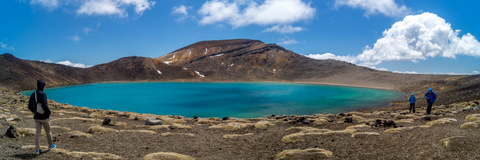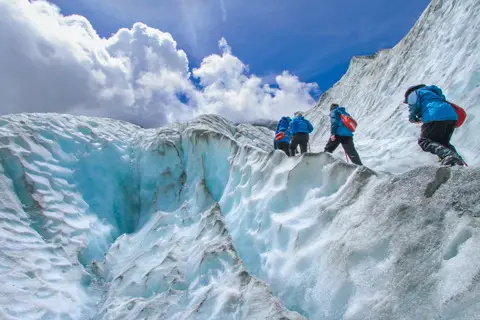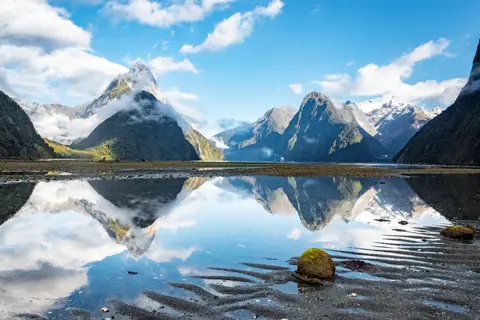Remote Natural Wonders of Australia & New Zealand
There’s no denying that Australia and New Zealand are some of the most remote destinations for travelers around the world to visit. Australia was the last inhabited continent to be discovered by Europeans and to this day requires nearly a full day of flying to reach when coming from Europe or the Americas.
Australia is regarded as the oldest landmass on Earth, while New Zealand sits on top of a submerged continent just a short distance from Australia across the Tasman Sea. While the big cities of both countries are home to millions of people, there are vast stretches of remote natural wonders where the wildlife far outnumbers human inhabitants. Come find out about some of the top remote natural wonders to be found in both Australia and New Zealand and discover the best ways to see them.


Australia’s and New Zealand’s Natural Side and Indigenous History
While Australia may have been the last inhabited continent to be discovered by Europeans, its lands are home to Earth’s oldest continuous society dating back roughly 65,000 years according to some researchers’ estimates. It is in Australia’s more remote destinations where early signs of Indigenous Australians can still be seen today. It is also in these destinations where you are likely to encounter Australia’s rare and endangered wildlife.
New Zealand may offer less wildlife, but it makes up for this with some of the world’s most impressive selection of varied natural landscapes which include glaciers, rainforests, volcanoes, fjords, and geothermal springs. Once again, travelers are required to get off the beaten track away from the major cities to experience the true treasures of New Zealand.
Booking guided tours of remote Australia and New Zealand is the easiest and safest way to experience the remote corners of Australia and New Zealand. Dealing with Australia’s unforgiving Outback or New Zealand’s rugged coastlines and interior requires a great deal of planning, something that most travelers fail to prepare adequately for.
For instance, knowing how much fuel you’ll need and where it will be available, how to navigate unsealed roads that can often become flooded, and being knowledgeable about dangerous wildlife are all vital when exploring the remote regions of both Australia and New Zealand.
Not only will an organized tour provide you with skilled and knowledgeable local guides who will prioritize your safety, but you will also come away having experienced a truly immersive adventure. Guided tours also offer you the opportunity to see the harsh remote landscapes in comfort, as you are often treated to deluxe motorcoaches, first-class accommodation, and possibly even travel on cruise ships or legendary trains like Australia’s Indian Pacific.


Incredible Places to Explore in Australia
Nullarbor Plain
The Nullarbor Plain is a landscape that needs to be respected. It was once regarded as one of the most dangerous drives in Australia due to a lack of services and assistance along the way. While it may be a little safer completing this drive yourself today, the best way to see the seemingly endless Nullarbor is by hopping on the Indian Pacific luxury passenger train that runs from Sydney to Perth with a stopover in Adelaide.
The Indian Pacific will take you on the longest stretch of straight railway track in the world, passing by emus, kangaroos, and the world’s only feral herds of camels which were once brought to Australia to help with the building of the railway.
The Nullarbor is a peculiar place, being home to the world’s longest golf course, littered with meteorites, and even the crash site of the United States’ first space station called Skylab. As you reach the Great Australian Bight coastline to the south of the Nullarbor, towering sea cliffs drop hundreds of feet to the sea below where southern right whales migrate between June and October each year.


Kimberley Region
At the top of Western Australia lies a vast sparsely populated region known as the Kimberley. It is a remote place filled with waterfalls and natural swimming holes as well as canyons and unique mountain ranges. Its coastline runs along both the Indian Ocean and Timor Sea.
You can enjoy sunset camel rides along Broome’s Cable beach or search for prehistoric fossilized dinosaur footprints. Aboriginal rock art abounds in the region and their culture lives on in the various Aboriginal communities that dot the landscape.
The rough and sometimes challenging Gibb River Road cuts through the heart of the Kimberley and requires a great deal of planning, making a guided tour a much safer option. Other highlights include helicopter rides over Mitchell Falls, speedboat rides up the fascinating Horizontal Falls, sampling native bush tucker, and hiking the bushwalking trails of the El Questro Wilderness Park cattle station.


Island of Tasmania
Tasmania is Australia’s least populated state and you begin to notice the lack of people the minute you stray from the major cities like Hobart or Launceston. The entire south-eastern region of the island which covers an impressive 600,000 hectares is a mostly uninhabited national park known as Southwest National Park which forms part of the Tasmania Wilderness World Heritage Area.
One of the best ways to experience this fascinating wilderness is by taking a Gordon River cruise out of Strahan which will take you through Macquarie Harbour and Hells Gates as well as offering a stopover on the historic Sarah Island penal settlement.
Elsewhere in Tasmania, there are a number of other national parks where you can enjoy a slice of nature completely to yourself. While the popular parks such as Cradle Mountain and Freycinet get a lot of attention, there are still plenty of sections where you can enjoy trails all to yourself. There are also parks like Narawntapu, Rocky Cape, and Maria Island that allow you to isolate yourself even more from other people and replace them with incredible wildlife like Tasmanian devils, quolls, and rare endemic birds.


Red Centre
No trip to Australia is complete without witnessing its most famous natural landmark. The immense blazing orange-red monolith that is Uluru is a giant sandstone rock formation that is sacred to the local Aboriginal people. Walk around the base of Uluru to discover desert wildlife and Aboriginal rock paintings, while also learning about local Aboriginal culture.
The Red Centre centres around Alice Springs, and there is much more to see than just Uluru. The equally stunning Kata Tjuta, aka The Olgas, is another great hiking spot as is the rim of Kings Canyon. Other natural sites in the area to check out include Standley Chasm and Simpson Gap.
Listen to the sounds of didgeridoos and dingoes at night while being mesmerized by the 50,000 hand-crafted lights that form the magical Field of Light art installation. Check out the Alice Springs Desert Park for guaranteed sightings of local wildlife.
Incredible Places to Explore in Australia in New Zealand
Westland Tai Poutini National Park
New Zealand’s South Island is home to incredible glaciers which can be found along the west coast in Westland Tai Poutini National Park. Here, you can get helicoptered in to walk on Franz Josef Glacier and its neighbour Fox Glacier.
You can enjoy kayaking on Lakes Matheson and Mapourika, set to a backdrop of snow-capped peaks. In the mountainous regions, Himalayan tahr, chamois, and giant red deer roam which were introduced to New Zealand during the late 19th and early 20th centuries. The park is also a good region to spot rare birds like the Okarito kiwi with a bit of luck.
Milford Sound
The South Island of New Zealand is also home to the country’s largest national park which is Fiordland National Park. The highlight of the park is Milford Sound which can be accessed in a number of different ways. The truly adventurous will tackle the 4-day, 55-kilometre hike that begins at Lake Te Anau. More relaxing options include arriving by cruise ship or 4-hour motorcoach ride from Queenstown.
Regarded by many as a Wonder of the World, the area is known for its impressive waterfalls and sea cliffs. Wildlife also abounds and includes penguins, seals, and dolphins. Once in Milford Sound, which is actually a fjord, you can get out on the water via a boat trip or kayak or take to the air with a scenic flight.
Tongariro National Park
Heading over to the North Island of New Zealand, you’ll find the country’s oldest national park. Tongariro National Park offers stunning landscapes literally straight out of the movies. It is here where many scenes from the Lord of the Rings movies were shot.
The park is home to active volcanoes, lava flows from previous eruptions, and emerald-coloured lakes. You can experience the park by hiking the roughly 7-hour Tongariro Alpine Crossing which cuts through the volcanic terrain and is regarded as one of the world’s most iconic single-day treks.
During winter, the park offers great skiing and snowboarding and the area’s waterfalls including Taranaki Falls and Waitonga Falls become quite impressive during the spring snowmelt and after heavy rains.























